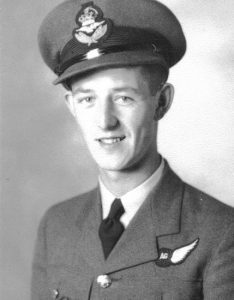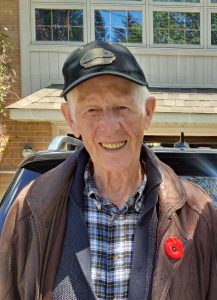
In the dead of night in western Poland, Albert Wallace made sand disappear. That winter of 1944, he trekked through snow, his RCAF airman’s pants concealing long sacks of sand excavated from secret escape tunnels. Inside a now darkened theatre, his German captors had allowed POWs to build inside their prison compound, Wallace quietly stepped into a designated row of seats.
“I was told to sit there because that’s where the trapdoor was,” Wallace said. “I sat in seat Number 13, pulled the sack strings and emptied the sand inside my pants through a trapdoor hidden under the seat.”
Shot down in May 1943, RCAF gunner Wallace had been interrogated, processed and deposited in notorious Stalag Luft III, the German prison camp for Commonwealth airmen near Zagan, Poland. He was one of about 800 Canadian air officers imprisoned there in the Second World War beginning in 1942.
Then a POW but also a member of the Allied escape committee, he’d volunteered to help make the sand dug from a tunnel codenamed Harry vanish without his German guards suspecting an escape attempt was coming. It was the famous Great Escape, which happened 80 years ago this Sunday.
There are days in my year – every year – when I stop to remember men and women from our community who’ve served Canada in uniform. Each June 6, I remember Queen’s Own Rifles infantryman Fred Barnard and RCAF ground crewman Cliff Robb, who both stormed ashore in Normandy on D-Day, 80 years ago.
Every August 19, I think of Steve Bell who landed with the Calgary Tanks at Dieppe in 1942. And when Battle of Atlantic Sunday in May comes along, I think of Navy vets Norman Goodspeed and my late neighbour WREN Ronnie Egan.
On March 24 it’s Al Wallace I’ll be remembering; his daughter Barb Trendos (who published Survival, a book of her father’s wartime experiences) recently moved into Uxbridge Township.
When P/O Wallace was first deposited inside Stalag Luft III POW camp, 81 years ago, he didn’t know that tunnel excavation for a planned mass escape had already begun beneath his new residence – North Compound, Hut 104, Room 23.
“I had no idea I was actually in the tunnel room,” he told me when I was researching my book on the Great Escape. “I didn’t know for weeks that goddamn tunnel (trapdoor) was just seven feet from my bunk bed.”
If I’ve learned one thing about Canadians in wartime predicaments, it’s how resourceful they were. No greater challenge confronted a man’s physical or mental well-being than surviving the prison camp the Germans called “inescapable.”
That first winter, as Wallace learned to make sand disappear for the escape committee, he also faced the dilemma of keeping himself and his comrades from freezing to death in their barracks. They discovered that the Germans housed a kitchen facility inside the compound with cooking gear, stoves and coal briquettes. Before long, the Canadian POWs found a way to break into the kitchen, fill their kitbags with the coal and stockpile the pilfered briquettes inside their hut.
“We had so much coal in our room, but there were few spots to hide it,” he said. “We put under our bunks. We put it in our Red Cross boxes. And we’d be in our shirt sleeves, hotter than hell, and guys would come in muffed up to their necks with tuques. And we’d say, ‘Oh, the heat? It’s just our new chimney.’”
Albert Wallace contributed sufficiently to the escape committee’s efforts that he earned a spot among those chosen to escape through Tunnel Harry on the night of March 24, 1944. He chose not to go. “We were 800 miles from England. Escape through Germany with 80 million people all speaking German and I spoke only English? It’d take a miracle to get back.”
His decision to stay behind saved his life. Of the 80 who emerged from Harry that night, 77 were captured within days (including nine Canadians). Hitler had 50 of the escapers executed (six of them Canadian) and their cremated remains (disguising their murders) returned to the POW camp.

And it was that sobering outcome that kept men such as Al Wallace from making much of their roles in the Great Escape. Getting home was reward enough. Still, I’ll never forget the night the Roxy screened the Steve McQueen movie back in 2014, then following, I introduced Al Wallace “the man who made sand disappear in the Great Escape.”
The audience stood and applauded him for minutes on end, for heroism he’d always denied, but always deserved.